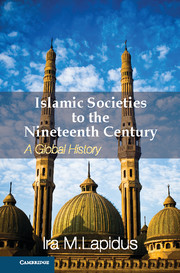Book contents
- Frontmatter
- Contents
- List of Illustrations
- List of Figures
- List of Maps
- List of Tables
- Preface
- Acknowledgments
- Acknowledgments to the first edition of A History of Islamic Societies
- Acknowledgments to the second edition of A History of Islamic Societies
- Publisher's Preface
- Introduction to Islamic Societies
- Part I The Beginnings of Islamic Civilizations
- Part II From Islamic Community to Islamic Society
- Egypt, Iraq, and Iran, 945–C. 1500
- Chapter 20 The Post-ʿAbbasid Middle Eastern State System
- Chapter 21 Muslim Communities and Middle Eastern Societies: 1000–1500 CE
- Chapter 22 The Collective Ideal
- Chapter 23 The Personal Ethic
- Chapter 24 Conclusion: Middle Eastern Islamic Patterns
- Part III The Global Expansion of Islam from the Seventh to the Nineteenth Centuries
- Glossary
- Bibliography
- Annotated Bibliography from A History of Islamic Societies, 2nd Edition
- Index
Chapter 20 - The Post-ʿAbbasid Middle Eastern State System
Published online by Cambridge University Press: 05 February 2013
- Frontmatter
- Contents
- List of Illustrations
- List of Figures
- List of Maps
- List of Tables
- Preface
- Acknowledgments
- Acknowledgments to the first edition of A History of Islamic Societies
- Acknowledgments to the second edition of A History of Islamic Societies
- Publisher's Preface
- Introduction to Islamic Societies
- Part I The Beginnings of Islamic Civilizations
- Part II From Islamic Community to Islamic Society
- Egypt, Iraq, and Iran, 945–C. 1500
- Chapter 20 The Post-ʿAbbasid Middle Eastern State System
- Chapter 21 Muslim Communities and Middle Eastern Societies: 1000–1500 CE
- Chapter 22 The Collective Ideal
- Chapter 23 The Personal Ethic
- Chapter 24 Conclusion: Middle Eastern Islamic Patterns
- Part III The Global Expansion of Islam from the Seventh to the Nineteenth Centuries
- Glossary
- Bibliography
- Annotated Bibliography from A History of Islamic Societies, 2nd Edition
- Index
Summary
The “medieval” era in the Middle East is the period after the breakup of the ʿAbbasid Empire and before the consolidation of the Ottoman and Safavid empires. Numerous and often ephemeral regional states replaced a unified empire. (See Map 4.) With the weakening of central governments and the rise of semiautonomous military, civic-religious, and land-controlling elites, it is no longer possible to recount Middle Eastern history from a central point of view. Its history is best understood by distinguishing the eastern parts of the Middle East – including Transoxania, Iran, and Iraq – from the western parts – consisting primarily of Syria and Egypt.
In the east, the first generation of regimes that succeeded to the domains of the ʿAbbasid Empire included the Buwayhids, mercenary soldier-conquerors from the Caspian Sea region, in Iraq and western Iran (945–1055); the Samanids, a provincial noble family already in power in the late ʿAbbasid era, in eastern Iran and Transoxania (to 999); and the Ghaznavids, a dynasty founded by slave soldiers in Afghanistan and Khurasan (to 1040). These regimes gave way to a succession of nomadic empires as the collapse of the ʿAbbasid Empire broke down the frontiers between the settled parts of the Middle East and Inner Asia and allowed Turkish nomadic peoples to infiltrate the region. In the tenth century, the Qarakhanids took control of Transoxania. In the eleventh century, the Saljuqs seized Iran, Iraq, and Anatolia. Ghuzz and Nayman followed in the twelfth century; the Mongols conquered most of the region in the thirteenth.
- Type
- Chapter
- Information
- Islamic Societies to the Nineteenth CenturyA Global History, pp. 225 - 263Publisher: Cambridge University PressPrint publication year: 2012

